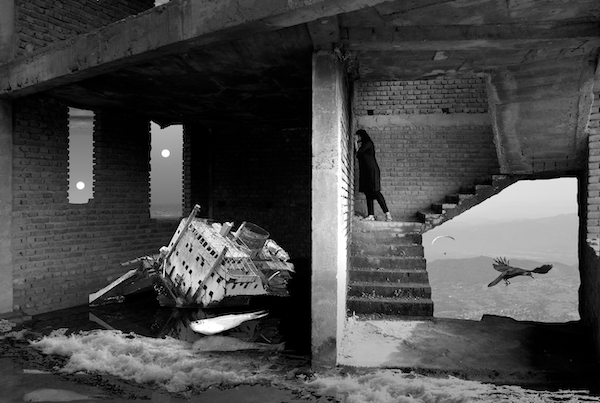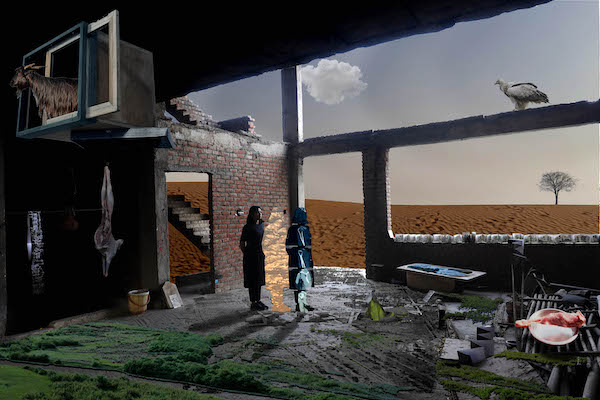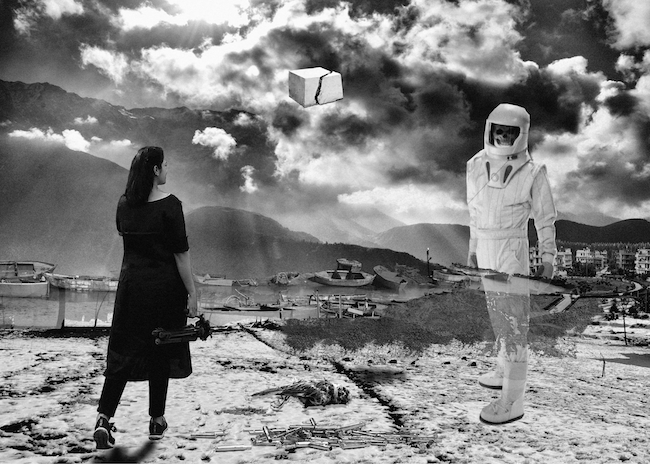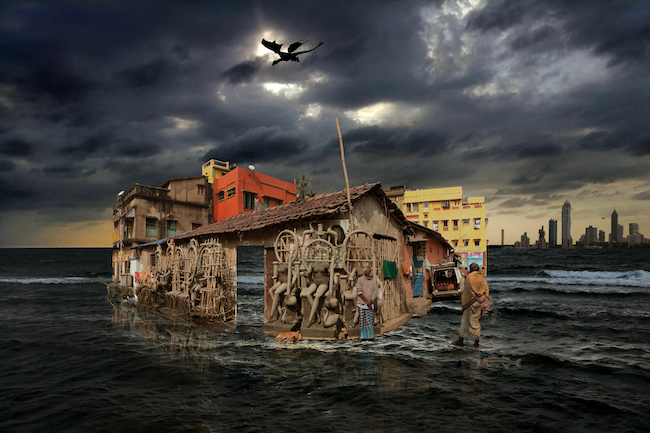Interview with Aditi Aggarwal
Colette Copeland
July 2024
 Dream 6 – The Ship, from the series ‘In Dream—Between Fact and Fiction’,
Dream 6 – The Ship, from the series ‘In Dream—Between Fact and Fiction’,
Digital PhotoMontage – also translated to Gum Bichromate Print, 2023
I met Delhi artist Aditi Aggarwal in an online class facilitated by renowned artists RAQS Media Collective at The Alternative Art School. I’ve taken many classes at TAAS and meeting artists from around the world is one of the greatest benefits. As part of my Fulbright research, I’ve interviewed contemporary female Indian artists whose work addresses socially engaged themes. When Aditi presented her work to our class, I immediately connected with her digital montages exploring themes of one’s place within a rapidly changing urban environment.
Colette Copeland: Two adjectives that come to mind when viewing your work from the As We Rise series and In Dream—Between Fact and Fiction are surreal and dystopic. Surrealism’s legacy is rich with dreamscapes and disparate objects within fractured landscapes. Although the surrealism movement is most associated with painting and film, photography has used montage as a tool to delve into the unconscious, as well as present utopic and dystopic realities. How has surrealism inspired your work?
Aditi Aggarwal: Surrealism and Automatism have significantly influenced my work, particularly through their ability to blur the lines between reality and imagination. Automatism, as practiced by Surrealist artists, involves the spontaneous and automatic generation of images and ideas without conscious planning or control, allowing the subconscious mind to guide the creative process. This technique opens a gateway to unexpected juxtapositions and dream-like scenarios, providing a rich terrain for exploring the deeper layers of the human psyche.
In the As We Rise series, I employ dream-like imagery to juxtapose familiar urban landscapes with fantastical elements. For instance, in one of the compositions, I place a floating city above a crumbling urban street, symbolizing the fleeting nature of modern civilization and the fragility of human achievements. By merging the tangible with the ethereal, I aim to create a visual dialogue that invites viewers to reconsider their perceptions of reality and explore the hidden narratives within everyday life.
In Dream—Between Fact and Fiction, I explore the subconscious mind by incorporating symbols such as decaying buildings and overgrown flora. These elements suggest a world where nature reclaims human-made structures, reflecting my concerns about environmental degradation and the loss of natural habitats. The fragmented, collage-like approach in these montages draws inspiration from Max Ernst’s surrealist collages and his illustrated books, where disjointed images converge to create a new, often unsettling narrative. Through this technique, I aim to evoke a sense of unease and prompt reflection on the fragile balance between human progress and the natural world.
CC: You trained as a painter at University of Delhi, College of Art. In the photo montage work, I see the connection to painting in how you rupture the pictorial plane in the compositions to provide visual interest, but also a disorienting perspective for the viewer. This also serves to collapse time, merging past, present and future. How did you transition from painting to photography?
 As We Rise – 2, Digital PhotoMontage, 2020-21
As We Rise – 2, Digital PhotoMontage, 2020-21
AA: Institutionally trained as a painter, my artistic journey was profoundly influenced by my father, a professional photographer. Since childhood, I assisted him in his photographic practice and business. By the time I was in grade 6 or 7, I knew how to develop film rolls in the darkroom, create contact sheets, use enlargers to make the prints, spending countless hours in his studio, which was located on the ground floor of our house. As his practice transitioned from analog processes to digital for commercial purposes, I helped him edit images in Photoshop, tailoring them to the specific aesthetic as desired by the advertising agencies he worked with on freelance basis.
This early exposure, combined with my own training as a painter, spurred me to further explore and experiment with alternative photographic techniques and various technologies. Having access to a darkroom and analog film space since childhood inspired me to use these tools to create images, narratives, and compositions.
I see my practice as a confluence of printing, painting, photography, and collage-making, creating a unique space where these mediums interact and enrich each other. Through painting, I can add color, form, and texture in a way that directly responds to the printed layers beneath. This manual intervention allows for a dynamic interplay between the controlled, mechanical aspects of printing and the fluid, spontaneous nature of painting. I often use painting to highlight, obscure, or transform elements of the printed base, creating a dialogue between the mediums.
Photography serves as the foundation of my practice, helping me capture and interpret reality through my lens. It provides a source of imagery that I can incorporate into my photomontages, prints, and paintings. Photographic elements can be directly transferred into prints, manipulated in digital processes, or used as references for painted components.
CC: The two montage series include self-portraits. You appear as the central protagonist in desolate, deserted and decayed urban environments. I interpret your figure as a witness, but also as a time-traveler, moving between different planes of “fractal realities” as you describe them. Please expand upon the significance of the human figure and the decision to use yourself as the central character in these narratives.
AA: I have always been fascinated by the genre of self-portraiture. As a painter, the idea of blurring the line between the seer and the seen intrigues me.
My PhD thesis, submitted at the University of Delhi, focused on “Autobiography and Self-Portraiture: An Exploration of Identity in Visual Arts with a focus on Contemporary Indian Artists based out of Delhi NCR (Post-2000).” My research delved into the evolution and contemporary manifestations of self-portraiture, particularly among artists in Delhi NCR, and their exploration of identity. Tracing its historical roots from ancient civilizations to the Renaissance and beyond, the study examined the progression of self-portraiture as a genre, highlighting its significance in both Western and Indian art traditions. In contemporary Delhi NCR, artists confront the challenge of depicting themselves amidst a rapidly evolving technological and societal landscape. Through mediums ranging from painting to multimedia installations, they navigate themes of self-expression, societal influence, and the impact of technology on identity formation. My thesis encompassed findings dedicated to historical accounts, Indian contributions, societal influences, and psychological dimensions, among others. My PhD journey instilled in me a commitment to archival practices, as I documented my surroundings, objects, and memories as sources of inspiration. This process of archiving not only facilitated introspection but also provided a framework for exploring the politics of connectivity and inclusion within my artistic narrative.
Using myself as the central character in these montages personalizes the broader themes I explore. My presence in these desolate environments serves as a bridge between the viewer and the narrative, offering a human perspective on the abstract and often overwhelming concepts of urban decay and environmental collapse.
 Dream 5 – Conversation with the Alien, from the series ‘In Dream—Between Fact and Fiction’,
Dream 5 – Conversation with the Alien, from the series ‘In Dream—Between Fact and Fiction’,
Digital PhotoMontage – also translated to Gum Bichromate Print, 2023
In Dream—Between Fact and Fiction (Conversation with the Alien, 2023) I appear in a self-portrait beneath a sky with a granite like planet, unfolding like a dream. The setting exudes an aura of dystopia and unreality, with elements of both beauty and foreboding intertwined. I am trapped in strange and mysterious circumstances, with mountains looming in the background against a cloudy sky. The scene is a collage of disparate sequences and circumstances, packed into one tableau, much like an indecipherable dream. In the middle ground, towards the right-hand corner, lies the Kaladham complex, my current residence, juxtaposed against a scene from serene Kashmir on the opposite side. Here, boats float on tranquil waters, evoking a sense of anticipation for tourists yet to arrive. In the foreground, a pile of used bullets and a dead sparrow serve as haunting symbols of a mysterious future. This composition, created using the Gum Bichromate Printing Process, invites viewers to contemplate the nature of existence and the passage of time.
In the As We Rise series, my figure often appears small and insignificant against the backdrop of towering, crumbling structures, emphasizing the vulnerability and transience of human life within the grand scale of urbanization. For instance, in one of the unfinished compositions, I am depicted standing on the edge of a collapsed building, looking out over a desolate cityscape, symbolizing both the isolation and the resilience of the human spirit.
My self-portraits in these series indeed serve as a witness and a time-traveler, moving between different planes of “fractal realities.” This use of my own image allows me to explore personal narratives within broader socio-political contexts, creating a more intimate and immediate connection with the viewer.
The self-portraiture approach enables me to engage deeply with themes of identity, memory, and the unknown, inviting viewers to embark on a journey through the recesses of the subconscious mind. It is a compelling portrayal of a world in flux—a world where past, present, and future collide in a kaleidoscope of images and emotions.
CC: As you know, my Fulbright research centers on artists whose work examines issues of borders and boundaries. Your juxtaposition of disparate images creates a collision of sorts, as well as collapses established boundaries between eroding, unfinished cityscapes, environmental issues and fraught political climates. How does your work address these themes?
AA: My work addresses issues of borders and boundaries by highlighting the fluid and often contentious intersections between different realms—urban and natural, past and present, reality and imagination.
In the As We Rise series, I juxtapose images of modern, unfinished cityscapes with elements of decay and destruction, suggesting the fragile and often illusory nature of progress and development.
In one of the (unfinished) compositions Dream—Between Fact and Fiction, I explore environmental issues by blending images of decayed urban infrastructure with lush, overgrown vegetation. This creates a visual narrative that questions the boundaries between human civilization and the natural world. Another one, shows a city street submerged under water, with fish swimming among the ruins, symbolizing the impact of climate change and rising sea levels on urban areas.
These visual collisions serve to collapse established boundaries and provoke critical reflection on the interconnectedness of environmental, social, and political issues. By merging disparate images, I aim to create a dialogue about the consequences of human actions on our world and the urgent need for more sustainable and equitable practices.
 As We Rise -1 (After Kumortuli), Digital PhotoMontage, 2020-21
As We Rise -1 (After Kumortuli), Digital PhotoMontage, 2020-21
CC: What are you most excited about in your work right now?
AA: Right now, I am most excited about experimenting with varied technologies, both new and old.
I am working with handmade cameras and customizable cells to capture and interpret the urban experience. These explorations allow me to blend traditional craftsmanship with contemporary technological innovations, creating a unique lens through which I view and document the world around me.
Simultaneously, I’m working on prints that involve Gum Bichromate printing, an alternative photography printing process. Gum Bichromate printing is a fascinating non-silver method that involves coating paper with a solution of gum arabic containing potassium or ammonium bichromate, along with pigment for image tones. What intrigues me about this process is the unpredictability inherent in its outcome. The tones achieved can vary depending on factors such as the temperature at which the batch of emulsion is made. This experimentation with Gum Bichromate printing allows me to blur the boundaries between traditional printing techniques, painterly approaches, and photographic processes.
I relish the challenge of navigating this interdisciplinary space, where each print is a unique fusion of technique and artistic expression. Embracing the unpredictability of the medium, I find myself constantly pushed to explore new possibilities and push the boundaries of my creativity.
As part of her Fulbright Research Award in India, Colette Copeland has been doing a series of interviews with socially engaged artists whose work explores themes of borders and boundaries.
Interview with Vishnupriya Rajgarhia →
Interview with Hiten Noonwal →
Interview with Parvathi Nayar →
Interview with Manmeet Devgun →
Interview with Moutushi Chakraborty →
Interview with Riti Sengupta →
Interview with Jyotsna Siddharth →
Interview with Mallika Das Sutar →
Colette Copeland is an interdisciplinary visual artist, arts educator, social activist and cultural critic/writer whose work examines issues surrounding gender, death and contemporary culture. Sourcing personal narratives and popular media, she utilizes video, photography, performance and sculptural installation to question societal roles and the pervasive influence of media, and technology on our communal enculturation.
